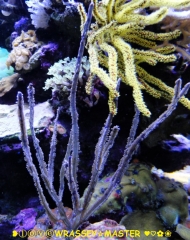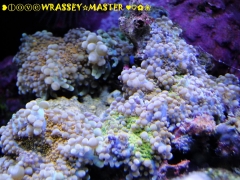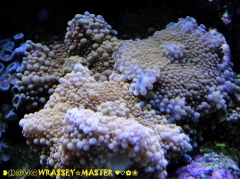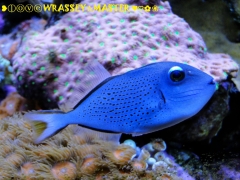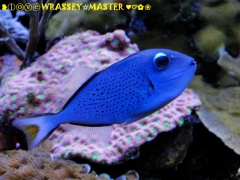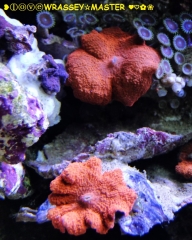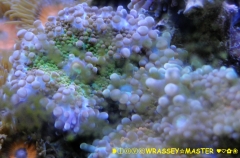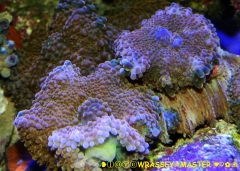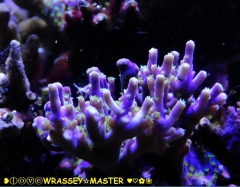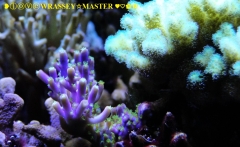-
Posts
4,897 -
Joined
-
Last visited
-
Days Won
7
Content Type
Profiles
Forums
Gallery
Everything posted by kueytoc
-
Simply FANTASTICO !!!
-

Purple Blade (Pterogorgia guadalupensis)
kueytoc commented on kueytoc's gallery image in Members Gallery
-

BID: mini purple true octo for pico/nano
kueytoc replied to dnsfpl's topic in Sell off/Pasar Malam Shop
SGD25 -
From the album: WRASSEYMASTER® Reef Paradise
-
From the album: WRASSEYMASTER® Reef Paradise
-
From the album: WRASSEYMASTER® Reef Paradise
The Stalked Ascidian or Clavelina robusta, is a species of sea squirt in the genus Clavelina (little bottles). It is found in the Western Pacific, Australia, Indonesia, Philippines, Japan and the Solomon Islands. Like all ascidians, this is a filter feeder. This species is commonly found living in large clusters. It has large 0.8 to 1.5 inch cylindrical zooids. This creature ranges from black to dark blue to gray in color, with individual zooids having fluorescent green, yellow, or white rings around both siphons. The external cover has a firm basal (primitive) matrix, and is somewhat transparent and soft. -

‘Tiger Sponge’ or Botrylloid Tunicate (Botrylloides sp.)
kueytoc posted a gallery image in Members Gallery
From the album: WRASSEYMASTER® Reef Paradise
A social sea squirt (Synascidian), a member of the Ascidiacae, or tunicate, family.- 1 comment
-
- (Botrylloides sp.
- Botrylloid Tunicate
-
(and 1 more)
Tagged with:
-

Sargassum Triggerfish or Red-Tailed Triggerfish aka Xanthichthys ringens
kueytoc posted a gallery image in Members Gallery
From the album: WRASSEYMASTER® Reef Paradise
The Sargassum Trigger (Xanthichthys ringens) is one of the more passive planktivore trigger species. They are light grey in color with darker navy blue speckles on the body and stripes on the "cheek" area. The "eyelids" are light blue and the tail is trimmed in red with a red crescent at the end. The fins may have yellow trim. Odonus, Melichthys, and Xanthichthys genera are generally less aggressive or destructive and some may even be kept successfully in community or reef aquariums but be aware that they still may prey on inverts (especially crustaceans) or on smaller tankmates.-
- Sargassum Triggerfish
- Xanthichthys ringens
- (and 1 more)
-

Sargassum Triggerfish or Red-Tailed Triggerfish aka Xanthichthys ringens
kueytoc posted a gallery image in Members Gallery
From the album: WRASSEYMASTER® Reef Paradise
The Sargassum Trigger is one of the least aggressive Triggers available. Unlike most Triggerfish, this species will not bother corals or sessile invertebrates such as anemones, clams, and sponges. This trigger is not known to harass other tankmates, but should be kept with similar sized fish with similar temperament as well. The Sargassum Trigger vocalizes using grunting sounds, and is found in the wild around Sargassum weed. Sargassum Trigger is one of the few triggers that can be kept in the reef aquarium. It will not bother corals and usually ignore sessile invertebrates. It can be kept with moderately-aggressive tankmates and can even be kept in groups in extra large aquariums. This trigger rarely bothers its tankmates. Like many triggers, it is often shy when first added to the aquarium, but becomes bolder as it learns to associate its caretaker with food. It prefers lots of open swimming space and brisk water movement. Juveniles associate with rafts of Sargassum weed (hence the common name). Also known as Red Tailed Triggerfish (large males have some red on the edge of the tail.) The Sargassum Trigger has a rounded head and relatively small mouth. Its body is light blue-grey with three dark stripes on the cheeks, and dark spots arranged in rows covering its body. Maximum Size: Sargassum Trigger grows up to 12 inches in length. General Size: Sargassum Trigger generally comes in size varying between 4 to 8 inches. Minimum Tank Size: A 40 gallon or larger aquarium with rocks and caves provides a good habitat. It will rearrange the landscaping and rocks as it wanders in and out of the caves. May eat smaller tank mates as well a variety of invertebrates. Tank Conditions: The Sargassum Trigger should ideally be kept in temperatures between 72 and 78 degrees Fahrenheit. A pH value of 8.1 or 8.4, and a specific gravity of 1.020 to 1.025 should be maintained. When kept with invertebrates, the specific gravity range should be 1.020 to 1.025, for the invertebrate species. In a fish only aquarium, the specific gravity should fall between 1.020 and 1.023. Diet and Feeding: The Sargassum Trigger needs a varied diet of meaty foods including; squid, krill, clams, small fish and hard shelled shrimp to help wear down their ever growing teeth.-
- Red Tailed Triggerfish
- Sargassum Triggerfish
- (and 1 more)
-
Interesting to see reefers avoiding the rare opportunity of keeping the exotic Catalina Gobies due to its stringent requirement for cooler water temp which I beg to differ. In fact, I have successfully kept a Catalina Goby alive for more than a year in the standard temp range of 26-27C. Even more interesting to note that the LFS which I bought the fish from was housing the Catalina in a non-chilled partition tank compartment for weeks. You can read & viewed moi CATALINA beauty from my past weblink here: Hope the above assurance helps. Happy Reefing !!!
-
From the album: WRASSEYMASTER® Reef Paradise
-
From the album: WRASSEYMASTER® Reef Paradise
Actinodiscus (Discosoma) Common Species: A. cardinalis, A. mutabilis, A. striata, A. marmoratus Common names for Actinodiscus spp. are mushrooms, mushroom anemones, disc anemones, and mushroom corals. Actinodiscus corals prefer low intensity light. These come in a variety of colors: red, orange, green, blue, purple, and some metallics. In addition, Actinodiscus spp. may be solid in hue, or heterochromatic (more than one color in pie shape), as well as spotted, splotchy, or striped. Under high intensity lighting, the zooxanthellae of Actinodiscus species may become concentrated, leading to a dull or brown colored coral and completely obscuring the natural colors of the polyp. In general, these mushrooms are not considered predatory, so it is not necessary to directly feed them. They will do just fine with photosynthesis from their zooxanthellae and direct nutrient uptake from the water. Actinodiscus may sometimes be sold as Discosoma. -
From the album: WRASSEYMASTER® Reef Paradise
-
From the album: WRASSEYMASTER® Reef Paradise
Mushroom corals are distinct from other corals by their o.r.a.l disc. This is the umbrella shaped, or flat, circular disc which surrounds their opening. Their hypostomes, or mouths, protrude (think of pursed lips), unlike other corals that have flat or concave mouths. On their discs, they do have tentacles-but they look more like little bumps, warts, or beads (these tentacles are usually referred to as papillae or verrucae). The “stalk” of the mushroom is called the column, and where it attaches to the substrate is called the pedal disc (think of it as a “foot”). Mushroom corals are considered polytrophic. They do rely on zooxanthellae and photosynthesis for energy. In addition, many corallimorphs will absorb nutrients directly from the water. If there is an aggressive skimming process in your reef aquarium, your mushrooms may not thrive. Moreover, some mushrooms will prey on fish or other invertebrates. These piscivorous corals, notably Amplexidiscus fenestrafer, can quickly (within 3 seconds) enclose fish. Beware keeping clownfish and other anemone fish in the same aquarium with mushroom corals. Orange mushroom corals.Generally speaking, false corals prefer moderate lighting intensity and moderate water current. Mushrooms are commonly found in deeper waters, shaded waters, or directly beneath other corals. If your specimen is more of a pastel color, it may be stressed due to high lighting intensity, as well as other factors. As most mushrooms are found in deeper water, high currents or fluctuations in salinity are typically not tolerated. (Corals in shallow reef environments are more acclimated to fluctuations, especially of low salinity, as they might endure a deluge of fresh water in a rainstorm.) Despite these restrictions, mushroom corals are considered rather easy to keep and ideal for “beginner” aquarists. By and large, they seem to thrive in high nutrient waters (perhaps do to their ability to absorb nutrients from the water), so slightly higher nitrate levels should not be worrisome. Although there are some conflicting reports as to whether mushroom corals are aggressive, hobbyists should still give them space in their reef aquarium to account for growth of the colony. Additionally, mushroom corals grow quickly in ideal conditions in captivity, and will bud on a regular basis. Also, some polyps may detach from the substrate, and this is a great time to move it to a new home within your aquarium and start a second colony. -
From the album: WRASSEYMASTER® Reef Paradise
-
From the album: WRASSEYMASTER® Reef Paradise
-
From the album: WRASSEYMASTER® Reef Paradise
Ricordea This is the only genus in the family Ricordeidae. Common Species: R. yuma, R. florida Premium Tri-Color Florida Ricordea Coral Ricordea corals may often be called simply by their species names, referred to as Floridas or Yumas. Ricordea spp. are noted for their pimply appearance, as they are covered with papillae and verrucae, sometimes of contrasting color. Compared with other corallimorphs, Ricordea corals tolerate brighter light and shallow reef systems. These can be blue, green, yellow, orange, and pink. The brighter colors are normally found in the more shallow waters. Darker colors are from deeper waters. The tentacles and polyps cannot retract, and the coral cannot move on the substrate once it is attached (compare to other motile corals that walk to new homes). -
From the album: WRASSEYMASTER® Reef Paradise
Corallimorpharia corals are typically called Mushroom corals. Some hobbyists also call them disc anemones, false corals, elephant ear corals, umbrella corals, and mushroom false corals. These are not to be confused with the stony mushroom corals of Fungiidae or the mushroom leather corals of Sarcophyton spp. They are commonly called “false corals” because they are similar to the stony corals of Scleractinia and belong in the same subclass (Hexacorallia), but they lack the calcareous skeleton. Mushroom corals are in the order Corallimorpharia and the subclass Hexacorallia (or also known as Zoantharia). Being in the Hexacorallia subclass means that the polyps have tentacles in multiples of six. The Corallimorpharia families and their genera are as follows: Actinodiscidae: Actinodiscus, Corallimorphidae: Corallimorphus, Corynactis, Pseudocorynactis, Ricordeidae: Ricordea, Discosomatidae: Actinodiscus, Amplexidiscus, Discosoma, Metarhodactis, Orinia, Paradiscosoma, Rhodactis, Sideractiidae: Sideractis, Nextactis, Schincteractis. -
Woot-Woot
-
Are U setting up a new tank in ya new home ?
-
$52
-
From the album: WRASSEYMASTER® Reef Paradise
Colour Form: Bright Purple/Green Polyps Approx. Size: 4-6 cm Care Level: Moderate Lighting: High Waterflow: Moderate - High Water Conditions: 24-27 °C, dKH 8-12, pH 8.1-8.4, sg 1.023-1.025, Calc 400-450 -
From the album: WRASSEYMASTER® Reef Paradise
A stunning Acropora with dark purple tips and neon green polyps. Colouration is stunning, neon green polyps and wonderful bright purple tipped branches make this a must have SPS to add to any collection. Acro will have numerous growth tips and will grow in a tight cluster formation that will form a table effect. -
From the album: WRASSEYMASTER® Reef Paradise
The Purple Blade is a beautiful and hardy gorgonian that is found living in shallow sunlight flats of the Florida Keys and throughout the Caribbean. In the aquarium, it shouldn't be allowed to come into contact with other gorgonians, corals, or anemones to minimize inter-species aggression. Purple Blades prefer at least medium variety of lighting, but should have decent water flow, as they need it to occasionally shed a waxy film (much like a Sarcophyton sp. toadstool leather coral). The Purple Blade has a unique growth form unlike other photosynthetic gorgonians. Only the edges of the blades sport small polyps, allowing the purple color to be seen at all times.


